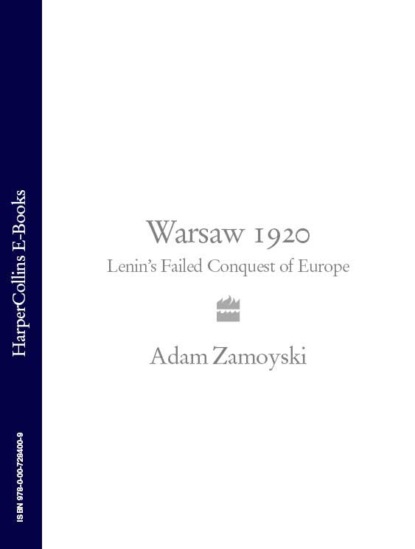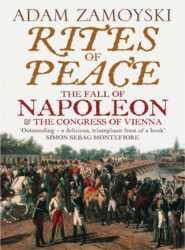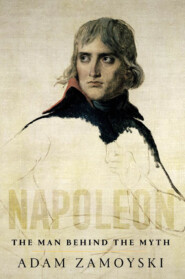По всем вопросам обращайтесь на: info@litportal.ru
(©) 2003-2024.
✖
Warsaw 1920: Lenin’s Failed Conquest of Europe
Настройки чтения
Размер шрифта
Высота строк
Поля
Warsaw 1920: Lenin’s Failed Conquest of Europe
Adam Zamoyski
The dramatic and little-known story of how, in the summer of 1920, Lenin came within a hair's breadth of shattering the painstakingly constructed Versailles peace settlement and spreading Bolshevism to western Europe.In 1920 the new Soviet state was a mess, following a brutal civil war, and the best way of ensuring its survival appeared to be to export the revolution to Germany, itself economically ruined by defeat in World War I and racked by internal political dissension.Between Russia and Germany lay Poland, a nation that had only just recovered its independence after more than a century of foreign oppression. But it was economically and militarily weak and its misguided offensive to liberate the Ukraine in the spring of 1920 laid it open to attack. Egged on by Trotsky, Lenin launched a massive westward advance under the flamboyant Marshal Tukhachevsky.All that Great Britain and France had fought for over four years now seemed at risk. By the middle of August the Russians were only a few kilometres from Warsaw, and Berlin was less than a week's march away. Then occurred the 'Miracle of the Vistula': the Polish army led by Jozef Pilsudski regrouped and achieved one of the most decisive victories in military history.As a result, the Versailles peace settlement survived, and Lenin was forced to settle for Communism in one country. The battle for Warsaw bought Europe nearly two decades of peace, and communism remained a mainly Russian phenomenon, subsuming many of the autocratic and Byzantine characteristics of Russia's tsarist tradition.
WARSAW 1920
Lenin’s Failed Conquest of Europe
ADAM ZAMOYSKI
COPYRIGHT
Harper Press
HarperCollinsPublishers
77-85 Fulham Palace Road,
Hammersmith, London W6 8JB
www.harpercollins.co.uk (http://www.harpercollins.co.uk/)
Published by HarperCollinsPublishers 2008
Copyright © Adam Zamoyski 2008
The author asserts the moral right to be identified as the author of this work
A catalogue record for this book is available from the British Library
All rights reserved. No part of this publication may be reproduced, stored in a retrieval system, or transmitted, in any form or by any means, electronic, mechanical, photocopying, recording or otherwise, without the prior permission of the publishers.
HarperCollinsPublishers has made every reasonable effort to ensure that any picture content and written content in this ebook has been included or removed in accordance with the contractual and technological constraints in operation at the time of publication.
Source ISBN: 9780007225521
Ebook Edition © DECEMBER 2014 ISBN: 9780007284009
Version: 2014-10-31
Contents
Cover (#u28708425-b06e-5421-a6ee-c71a5743ef5b)
Title Page (#u7b9e2948-5603-5e02-a786-29684cfcd843)
Copyright
List of Illustrations
List of Maps
Introduction
1 Old Scores and New Dawns
2 Playing Soldiers
3 Grand Designs
4 The Miracle on the Vistula
5 Settling the Scores
6 The Aftermath
Keep Reading (#litres_trial_promo)
Sources
Further Reading in English
Index
Also by the Author
About the Publisher
ILLUSTRATIONS
Pilsudski reviewing volunteers setting off for the front. (Centralne Archiwum Wojskowe, Warsaw)
Kamenev with soldiers of the Red Army. (The David King Archive, London)
Russian infantry on parade. (The David King Archive, London)
Russian heavy artillery outside Warsaw, August 1920. (The David King Archive, London)
A colour party of Red cavalry, spring 1920. (The David King Archive, London)
The Red cavalry’s secret weapon, the tachanka. (The David King Archive, London)
Polish field artillery in Pinsk, spring 1920. (Centralne Archiwum Wojskowe, Warsaw)
The Polish 16th Lancers marching through Równe, March 1920. (Biblioteka Ksiazat Czartoryskich, Kraków)
Polish heavy artillery in Ukraine, May 1920. (Centralne Archiwum Wojskowe, Warsaw)
The Polish Air Force’s Kosciuszko Squadron, made up of American volunteers. (The Polish Institute and Sikorski Museum, London) Polish armoured train. (Centralne Archiwum Wojskowe, Warsaw)
Adam Zamoyski
The dramatic and little-known story of how, in the summer of 1920, Lenin came within a hair's breadth of shattering the painstakingly constructed Versailles peace settlement and spreading Bolshevism to western Europe.In 1920 the new Soviet state was a mess, following a brutal civil war, and the best way of ensuring its survival appeared to be to export the revolution to Germany, itself economically ruined by defeat in World War I and racked by internal political dissension.Between Russia and Germany lay Poland, a nation that had only just recovered its independence after more than a century of foreign oppression. But it was economically and militarily weak and its misguided offensive to liberate the Ukraine in the spring of 1920 laid it open to attack. Egged on by Trotsky, Lenin launched a massive westward advance under the flamboyant Marshal Tukhachevsky.All that Great Britain and France had fought for over four years now seemed at risk. By the middle of August the Russians were only a few kilometres from Warsaw, and Berlin was less than a week's march away. Then occurred the 'Miracle of the Vistula': the Polish army led by Jozef Pilsudski regrouped and achieved one of the most decisive victories in military history.As a result, the Versailles peace settlement survived, and Lenin was forced to settle for Communism in one country. The battle for Warsaw bought Europe nearly two decades of peace, and communism remained a mainly Russian phenomenon, subsuming many of the autocratic and Byzantine characteristics of Russia's tsarist tradition.
WARSAW 1920
Lenin’s Failed Conquest of Europe
ADAM ZAMOYSKI
COPYRIGHT
Harper Press
HarperCollinsPublishers
77-85 Fulham Palace Road,
Hammersmith, London W6 8JB
www.harpercollins.co.uk (http://www.harpercollins.co.uk/)
Published by HarperCollinsPublishers 2008
Copyright © Adam Zamoyski 2008
The author asserts the moral right to be identified as the author of this work
A catalogue record for this book is available from the British Library
All rights reserved. No part of this publication may be reproduced, stored in a retrieval system, or transmitted, in any form or by any means, electronic, mechanical, photocopying, recording or otherwise, without the prior permission of the publishers.
HarperCollinsPublishers has made every reasonable effort to ensure that any picture content and written content in this ebook has been included or removed in accordance with the contractual and technological constraints in operation at the time of publication.
Source ISBN: 9780007225521
Ebook Edition © DECEMBER 2014 ISBN: 9780007284009
Version: 2014-10-31
Contents
Cover (#u28708425-b06e-5421-a6ee-c71a5743ef5b)
Title Page (#u7b9e2948-5603-5e02-a786-29684cfcd843)
Copyright
List of Illustrations
List of Maps
Introduction
1 Old Scores and New Dawns
2 Playing Soldiers
3 Grand Designs
4 The Miracle on the Vistula
5 Settling the Scores
6 The Aftermath
Keep Reading (#litres_trial_promo)
Sources
Further Reading in English
Index
Also by the Author
About the Publisher
ILLUSTRATIONS
Pilsudski reviewing volunteers setting off for the front. (Centralne Archiwum Wojskowe, Warsaw)
Kamenev with soldiers of the Red Army. (The David King Archive, London)
Russian infantry on parade. (The David King Archive, London)
Russian heavy artillery outside Warsaw, August 1920. (The David King Archive, London)
A colour party of Red cavalry, spring 1920. (The David King Archive, London)
The Red cavalry’s secret weapon, the tachanka. (The David King Archive, London)
Polish field artillery in Pinsk, spring 1920. (Centralne Archiwum Wojskowe, Warsaw)
The Polish 16th Lancers marching through Równe, March 1920. (Biblioteka Ksiazat Czartoryskich, Kraków)
Polish heavy artillery in Ukraine, May 1920. (Centralne Archiwum Wojskowe, Warsaw)
The Polish Air Force’s Kosciuszko Squadron, made up of American volunteers. (The Polish Institute and Sikorski Museum, London) Polish armoured train. (Centralne Archiwum Wojskowe, Warsaw)











